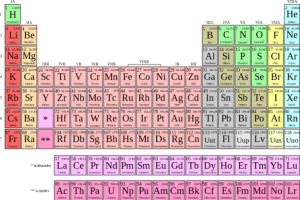Playlist
Show Playlist
Hide Playlist
Hydrogen Bonds – How Atoms Come Together to Form a Molecule
-
Slides 03 AtomsFormsMolecules CellBiology.pdf
-
Reference List Molecular and Cell Biology.pdf
-
Download Lecture Overview
00:00 Here we'll start looking at hydrogen bonds. Now hydrogen bonds always sound like the strongest of the bonds. I don't know maybe it has something to do with hydrogen bomb but it's nothing like that. 00:12 Hydrogen bonds are actually the weakest of the biological bonds that we'll be looking at in this course. So, let's start by looking at water. Again water is a covalently bonded molecule itself. But between water molecules we're actually going to see hydrogen bonding. 00:31 So, taking a look at water we see that oxygen has a valence electron. Six valence electrons and thus a valence of two. It would like two more electrons. Before, we looked at oxygen sharing with oxygen to create a double covalent bond but oxygen has other options. 00:52 In this case, we'll have two bonds with hydrogens. So each of those two hydrogens contribute one shared electron and now oxygen is happy with its octet rule. Eight electrons in the outer shell. 01:07 And the two hydrogen ions are also satisfied by sharing their electrons with the oxygen. 01:16 So they only need two in their outer shell. So, we have two covalent bonds from hydrogen to oxygen and hydrogen to oxygen. 01:28 So because oxygen is more electronegative we have a polar molecule. What I mean by this is oxygen has little bit more draw for the electrons that hydrogen is sharing with it. It's kind of greedy. 01:46 And so because it's pulling electrons more towards its center, oxygen ends up with a slightly negative charge. So it's more electronegative which means it has more draw for the negative electrons. 02:03 So the other end of the molecule would be the hydrogen end of the molecule. And the hydrogen end of the molecule has a slightly positive charge. Because the oxygen end of the water molecule has a slightly negative charge and the hydrogen end of the water molecule has a slightly positive charge, the opposite ends of the molecule are attracted to other water molecules such that the hydrogen end of one water molecule is slightly attracted to the negative end of, the oxygen end of the water molecule. So in this case, this is why water will associate and become liquid at room temperature because the water molecules are in constant motion changing their associations. 02:51 So it's less strong of a positive negative difference than an ionic bond but a slight charge difference When we heat water, it will evaporate and that's because we're increasing the molecular motion and that positive negative attraction is not quite enough to hold the water molecules together. 03:11 So, water evaporates. When we freeze water, it becomes solid because those associations between positive and negative becomes stronger because cooler temperatures mean less molecular motion.
About the Lecture
The lecture Hydrogen Bonds – How Atoms Come Together to Form a Molecule by Georgina Cornwall, PhD is from the course Introduction to Cell Biology.
Included Quiz Questions
Which of the following is NOT true about hydrogen bonding?
- Three hydrogen atoms attach to an oxygen atom via hydrogen bonds to form a water molecule.
- Covalent and ionic bonds are stronger than hydrogen bonds.
- Hydrogen bonds are attractive intermolecular forces between a partially positive hydrogen atom of one molecule and a negative atom of another.
- Temperature affects hydrogen bonding in water.
- Hydrogen bonding makes water an excellent solvent for biological systems.
Why is water liquid at room temperature?
- Water molecules constantly change their associations with other water molecules through hydrogen bonding.
- Strong covalent bonds between oxygen and hydrogen ions participate in liquefication at room temperature.
- Decreased movement of water molecules helps water remain as a liquid at room temperature.
- Strong ionic bonds between water molecules keep water as a liquid.
Customer reviews
5,0 of 5 stars
| 5 Stars |
|
1 |
| 4 Stars |
|
0 |
| 3 Stars |
|
0 |
| 2 Stars |
|
0 |
| 1 Star |
|
0 |
Well done by the professor with full of transfer sense.




